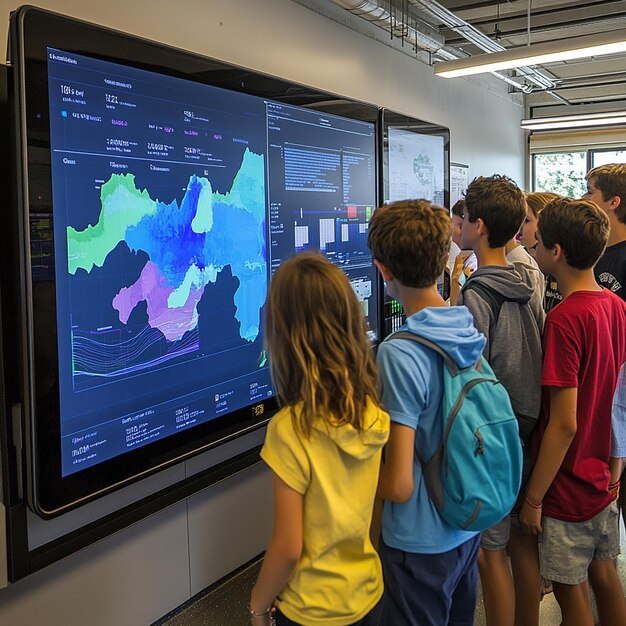AI’s Impact on Education: Opportunities & Challenges Unveiled

Anúncios
Artificial intelligence is rapidly transforming education, presenting both innovative opportunities for personalized learning and significant challenges related to equitable access, ethical considerations, and the evolving role of educators.
Anúncios
In an era defined by rapid technological advancements, the integration of artificial intelligence (AI) into various sectors is no longer a futuristic concept but a present-day reality. Among these, the field of education stands at a pivotal juncture, experiencing a profound transformation as AI technologies become increasingly sophisticated and accessible. Understanding the Impact of Artificial Intelligence (AI) on Education: Opportunities and Challenges is crucial for educators, policymakers, students, and parents alike, as it shapes the landscape of learning for generations to come. This exploration delves into how AI is redefining pedagogical approaches, administrative efficiencies, and the very nature of knowledge acquisition, while also critically examining the hurdles that must be navigated to ensure its beneficial and equitable implementation.
AI in Education: A New Frontier for Learning
The advent of artificial intelligence promises to revolutionize how we learn, teach, and administer educational institutions. AI-powered tools are moving beyond simple automation, offering sophisticated capabilities that were once the realm of science fiction. From intelligent tutoring systems to data-driven administrative platforms, AI is poised to unlock new possibilities for personalized and adaptive learning experiences.
This new frontier demands a comprehensive look at how these technologies can be leveraged effectively, ensuring they serve to enhance, rather than diminish, the human element of education. The focus is on creating dynamic, engaging, and highly individualized learning paths that cater to the unique needs and styles of each student.
Anúncios
Personalized Learning Pathways
One of the most significant opportunities presented by AI in education is its capacity to deliver truly personalized learning experiences. Unlike traditional one-size-fits-all models, AI can adapt to a student’s pace, preferences, and prior knowledge, offering content and exercises tailored to their specific needs.
- Adaptive algorithms identify a student’s strengths and weaknesses.
- Personalized content delivery adjusts to individual learning styles.
- Real-time feedback helps students understand and correct errors instantly.
- Learning paths evolve based on student performance and engagement.
This level of individualization can significantly improve learning outcomes, making education more effective and less frustrating for many students. It also frees up educators to focus on more complex tasks, such as fostering critical thinking and socio-emotional development, rather than routine instruction.
Automating Administrative Tasks
Beyond direct instruction, AI can streamline numerous administrative processes within educational institutions. This automation can lead to significant time savings and increased efficiency for teachers, administrators, and support staff, allowing them to dedicate more resources to core educational goals.
From grading assignments to managing enrollment, AI-powered systems can handle repetitive and data-intensive tasks with remarkable accuracy and speed. This not only reduces the administrative burden but also minimizes the potential for human error in critical processes.

AI’s role in administrative automation extends to areas like scheduling, resource allocation, and even predicting student retention rates. By analyzing vast datasets, AI can provide insights that help institutions make more informed decisions, optimizing operations and improving overall educational quality. This shift allows human capital to be redirected towards more impactful, student-centric initiatives.
In essence, AI in education is about re-imagining the entire learning ecosystem. It’s about empowering educators with tools that augment their capabilities, providing students with learning experiences that are both effective and engaging, and creating institutions that are more efficient and responsive to the needs of their communities. However, realizing this potential requires careful consideration of the challenges ahead.
Transforming Teaching Methodologies
The integration of AI is not merely about supplementing existing educational practices; it is fundamentally transforming teaching methodologies. Teachers are evolving from primary content deliverers to facilitators of learning, curators of resources, and mentors who guide students through personalized educational journeys. AI tools enhance their ability to understand student needs and intervene effectively.
This shift requires educators to adapt their skills, embracing new technologies and understanding how to best leverage them to create dynamic and effective learning environments. The focus moves from rote memorization to fostering critical thinking, creativity, and problem-solving skills, as AI handles the more repetitive aspects of instruction.
Data-Driven Insights for Educators
AI provides educators with unprecedented access to data-driven insights about student performance and engagement. Learning analytics, powered by AI, can identify patterns, predict potential learning difficulties, and recommend targeted interventions. This empowers teachers to make more informed decisions and tailor their support to individual students.
- Track student progress in real-time across various subjects.
- Identify specific areas where students struggle or excel.
- Receive alerts for students at risk of falling behind.
- Personalize assignments and resources based on individual data.
These insights allow for a proactive approach to teaching, addressing challenges before they become significant obstacles. It also enables teachers to demonstrate accountability and effectiveness through measurable improvements in student outcomes, providing a clear picture of their impact.
AI as a Teaching Assistant
Far from replacing teachers, AI can serve as a powerful teaching assistant, augmenting human capabilities and freeing up valuable time. AI-powered tools can grade essays, provide instant feedback on homework, and even answer common student questions, allowing teachers to focus on higher-level instruction and one-on-one mentorship.
Consider the potential for intelligent chatbots to provide 24/7 support for students struggling with concepts or needing clarification on assignments. This constant availability can significantly reduce student frustration and improve comprehension, especially for those who might be hesitant to ask questions in a traditional classroom setting.
Furthermore, AI can assist in content creation, suggesting relevant articles, videos, and interactive exercises based on lesson objectives. This reduces the preparation burden on teachers, enabling them to explore new pedagogical approaches and dedicate more energy to inspiring and engaging their students. The dynamic between teacher and student is enriched, shifting towards a more collaborative and personalized learning relationship.
Challenges and Ethical Considerations
Despite the immense potential, the widespread adoption of AI in education is not without its significant challenges and ethical considerations. Navigating these complexities is paramount to ensure that AI serves as a beneficial force for all learners and does not exacerbate existing inequalities or create new problems. Thoughtful implementation and robust policy frameworks are essential.
Addressing these concerns upfront is crucial to building trust and ensuring that AI tools are developed and deployed responsibly. A holistic approach is required, one that balances innovation with a deep understanding of human values and societal impacts.
Ensuring Equitable Access
One of the most pressing challenges is ensuring equitable access to AI-powered educational tools. The digital divide, already a significant barrier for many students, could widen if access to advanced AI technologies is limited to wealthier institutions or communities. This could perpetuate existing educational disparities.
Moreover, the cost of developing and maintaining sophisticated AI platforms can be prohibitive for many schools, especially those in underserved areas. Strategies must be put in place to ensure that these powerful tools are available to all students, regardless of their socioeconomic background or geographical location. Public-private partnerships and government funding initiatives could play a vital role in bridging this gap.
Data Privacy and Security Concerns
AI systems rely heavily on student data to personalize learning experiences. This raises serious concerns about data privacy and security. Protecting sensitive student information from breaches and misuse is paramount, and robust regulatory frameworks are needed to govern how this data is collected, stored, and utilized.
- Ensuring compliance with data protection laws (e.g., FERPA in the US).
- Implementing strong encryption and cybersecurity measures.
- Establishing clear policies on data ownership and sharing.
- Educating stakeholders about data privacy best practices.
Transparency regarding data practices is also essential. Students, parents, and educators must understand what data is being collected, why it is being collected, and how it is being used. Without this transparency, trust in AI technologies in education will be difficult to establish and maintain.
Bias in AI Algorithms
AI algorithms are trained on data, and if that data contains biases, the AI system will inevitably perpetuate or even amplify those biases. In an educational context, biased algorithms could lead to unfair assessments, discriminatory recommendations, or perpetuate stereotypes, disproportionately affecting certain student populations.

Addressing algorithmic bias requires careful attention to data collection, model design, and ongoing auditing of AI systems. Developers and educators must work together to identify and mitigate biases, ensuring that AI tools promote fairness and equity for all learners. This involves diverse development teams and continuous monitoring of AI’s impact on different student groups.
The ethical implications extend to the potential for AI to stifle creativity or critical thinking if not carefully implemented. Over-reliance on AI for answers might reduce the development of problem-solving skills. Thus, a balanced approach is needed, where AI complements, rather than dictates, the learning process, preserving essential human cognitive development.
Rethinking the Role of Educators and Students
The pervasive influence of AI necessitates a fundamental rethinking of the traditional roles of educators and students. No longer confined to the role of knowledge disseminators, teachers are evolving into facilitators, coaches, and designers of learning experiences. Students, in turn, are transitioning from passive recipients of information to active participants, critical thinkers, and creators.
This paradigm shift underscores the need for continuous professional development for educators and a renewed focus on meta-skills for students. The goal is to prepare both groups for a future where collaboration with intelligent machines is commonplace and essential.
Empowering Educators as Guides
With AI handling more routine tasks and providing data insights, educators can dedicate more time and energy to their most impactful roles: guiding, mentoring, and inspiring students. They can focus on fostering critical thinking, creativity, and socio-emotional skills—abilities that AI cannot replicate.
Teachers will become expert navigators of AI tools, selecting the most appropriate technologies for their students’ needs and integrating them seamlessly into the curriculum. Their expertise in pedagogy and human development will be more valuable than ever, as they translate AI insights into actionable strategies for individual student growth.
This includes designing engaging projects, facilitating collaborative learning, and providing nuanced, human-centric feedback that AI systems might struggle to deliver. The educator’s role transforms into that of a master orchestrator of learning, leveraging technology to amplify their impact and connect deeply with their students.
Cultivating Student Autonomy and Critical Thinking
AI-powered personalized learning environments can foster greater student autonomy. Students can take more ownership of their learning journeys, exploring topics of interest at their own pace and choosing learning strategies that best suit them. This autonomy, however, must be paired with the development of critical thinking skills.
- Encouraging students to question AI outputs and processes.
- Developing media literacy to evaluate information from AI sources.
- Promoting problem-solving and higher-order thinking skills.
- Fostering self-regulation and metacognition in learning.
Students must learn to interact with AI critically, understanding its capabilities and limitations. They need to develop the ability to discern reliable information, question assumptions, and apply knowledge in complex, real-world scenarios rather than simply accepting AI-generated answers. This prepares them not just for academic success but for a future workforce increasingly reliant on AI technologies.
Ultimately, the aim is to create intelligent learners who can effectively collaborate with AI, using it as a powerful tool to enhance their capabilities. This means transcending the traditional notions of “teacher” and “student” to embrace a more dynamic, interconnected learning ecosystem where humans and AI work in synergy.
Curriculum Adaptation and Future Skills
The rapid advancement of AI demands a fundamental re-evaluation of educational curricula. Traditional subjects need to be updated to reflect the realities of an AI-driven world, and new skills must be incorporated to prepare students for future careers that will inevitably be impacted by artificial intelligence. Education systems must become more agile and responsive to technological shifts.
This adaptation is not just about teaching students how to use AI tools, but about understanding the underlying principles, ethical implications, and the broader societal changes that AI will bring. It’s about designing a curriculum that prepares students to thrive in an unpredictable future workforce.
Integrating AI Literacy and Ethics
It is becoming increasingly important to integrate AI literacy into the curriculum across all levels of education. Students need to understand how AI works, its capabilities, limitations, and its ethical implications. This includes topics such as data privacy, algorithmic bias, and the responsible use of AI.
Teaching AI ethics from an early age can help cultivate a generation of responsible digital citizens who can critically evaluate AI technologies and contribute to their ethical development. This goes beyond simply using AI tools; it involves understanding their societal impact.
Moreover, fostering an understanding of basic AI principles, even without deep technical knowledge, can demystify the technology and prepare students to interact with AI systems effectively throughout their lives and careers. This foundational understanding can empower them to be creators and innovators, not just consumers, of AI.
Developing “Human-Centric” Skills
While AI excels at tasks requiring data processing and pattern recognition, uniquely human skills like creativity, critical thinking, empathy, and complex problem-solving will become even more valuable. Curricula should prioritize the development of these “human-centric” skills that complement, rather than compete with, AI capabilities.
- Fostering creativity through art, design, and innovative projects.
- Enhancing critical thinking via debate, analysis, and research.
- Building emotional intelligence and collaborative skills through group work.
- Promoting adaptability and lifelong learning in a rapidly changing world.
The future workforce will require individuals who can collaborate effectively with AI, leveraging its strengths while applying unique human insights to solve novel problems. Education should therefore focus on cultivating these distinct human attributes, ensuring that students are well-equipped for roles that demand nuanced judgment and interpersonal skills.
Curriculum adaptation also includes promoting interdisciplinary learning, recognizing that real-world problems often require drawing knowledge from multiple fields. AI often intersects with various disciplines, making an integrated approach to education more relevant than ever. This prepares students for complex challenges that transcend traditional subject boundaries.
Future Outlook and Collaborative Innovation
The trajectory of AI in education is one of continuous evolution, promising even more sophisticated tools and transformative applications. The future outlook suggests a blend of AI and human intelligence, creating synergistic partnerships that redefine what is possible in learning. This future, however, is not predetermined; it will be shaped by ongoing research, ethical dialogue, and collaborative innovation among all stakeholders.
A proactive approach is necessary to harness AI’s full potential while mitigating its risks. This involves fostering an ecosystem where educators, technologists, policymakers, and communities work together to design and implement AI solutions that truly serve the best interests of learners worldwide.
Hybrid Learning Environments
The future of education is likely to see the proliferation of hybrid learning environments, seamlessly integrating online and offline learning, and human-led instruction with AI-powered tools. These models can offer the flexibility of remote learning alongside the benefits of in-person interaction, all enhanced by AI personalization.
Such environments could empower students to move fluidly between self-directed AI-driven modules and collaborative, teacher-facilitated discussions, optimizing both efficiency and depth of learning. The physical classroom could transform into a dynamic hub for collaboration, mentorship, and deeper conceptual exploration, while routine content delivery is handled by AI.
This hybrid model also opens avenues for addressing issues of scale and access, allowing high-quality, personalized education to reach a much broader audience. AI acts as a multiplier, extending the reach and impact of human educators and resources, making education more accessible globally.
Research and Development in EdTech AI
Continued investment in research and development within EdTech AI is crucial. This includes exploring new AI algorithms tailored for learning, developing more intuitive user interfaces, and conducting rigorous studies on the efficacy and ethical implications of AI in diverse educational settings. Innovation must be grounded in pedagogical principles.
- Developing AI that understands complex human emotions and social cues.
- Creating intelligent agents that can facilitate multi-student collaborative learning.
- Designing AI tools that promote creativity and unstructured problem-solving.
- Researching the long-term cognitive and social impacts of AI integration.
Collaboration between AI researchers, educators, cognitive scientists, and learning designers is essential to ensure that new technologies are not just technically impressive but also pedagogically sound and genuinely beneficial for student development. This interdisciplinary approach ensures that AI advancements are aligned with educational goals and human learning processes.
Ultimately, the future of AI in education hinges on a commitment to iterative development, continuous evaluation, and a shared vision. By embracing collaborative innovation and maintaining a learner-centric focus, we can sculpt an educational future where AI amplifies human potential, creating unprecedented opportunities for lifelong learning and societal progress. The journey is complex, but the rewards are potentially boundless.
| Key Aspect | Brief Description |
|---|---|
| 💡 Personalized Learning | AI tailors educational content and pace to individual student needs. |
| ⚙️ Administrative Efficiency | AI automates tasks like grading and scheduling, saving time for educators. |
| ⚠️ Ethical Challenges | Concerns over equitable access, data privacy, and algorithmic bias must be addressed. |
| 🚀 Future Skills | Curriculum must adapt to teach AI literacy and human-centric skills like creativity. |
Frequently Asked Questions About AI in Education
AI personalizes learning by using algorithms to analyze a student’s performance, learning style, and engagement. It then adapts content, pace, and feedback to match their unique needs, ensuring they receive tailored instruction and resources. This approach helps address individual strengths and weaknesses, making learning more effective and efficient for each student.
It is highly unlikely that AI will entirely replace human teachers. Instead, AI is expected to serve as a powerful tool that augments educators’ capabilities, automating administrative tasks and providing data insights. This allows teachers to focus on complex human-centric tasks like mentorship, fostering critical thinking, and socio-emotional development, enriching the learning experience.
Key ethical concerns include ensuring equitable access to AI tools, protecting student data privacy and security, and mitigating algorithmic bias. If not properly addressed, these issues could exacerbate existing educational inequalities or lead to unfair treatment and misrepresentation of diverse student populations, undermining trust in AI’s benefits.
Schools can ensure data privacy by implementing robust security measures, complying with data protection regulations (like FERPA), seeking explicit parental consent for data collection, and being transparent about how data is used. Regular audits of AI systems and strong contractual agreements with EdTech providers are also crucial to safeguard student information.
Students will need skills that complement AI capabilities, such as critical thinking, creativity, problem-solving, and emotional intelligence. AI literacy and ethics will also be essential, enabling students to understand, evaluate, and responsibly interact with AI technologies. Adaptability and a commitment to lifelong learning will be key for future success.
Conclusion
The impact of artificial intelligence on education is undeniably profound, presenting a dual landscape of exciting opportunities and complex challenges. AI has the potential to transform learning into a highly personalized and efficient process, enabling educators to gain deeper insights into student needs and streamlining administrative burdens. However, realizing this potential demands a proactive approach to address crucial issues such as equitable access, data privacy, and algorithmic bias. By carefully navigating these ethical considerations and fostering collaborative innovation, we can ensure that AI serves as a powerful catalyst for positive change in education. The future of learning, enriched by human ingenuity and intelligent technology, promises a more accessible, engaging, and effective educational experience for all.





